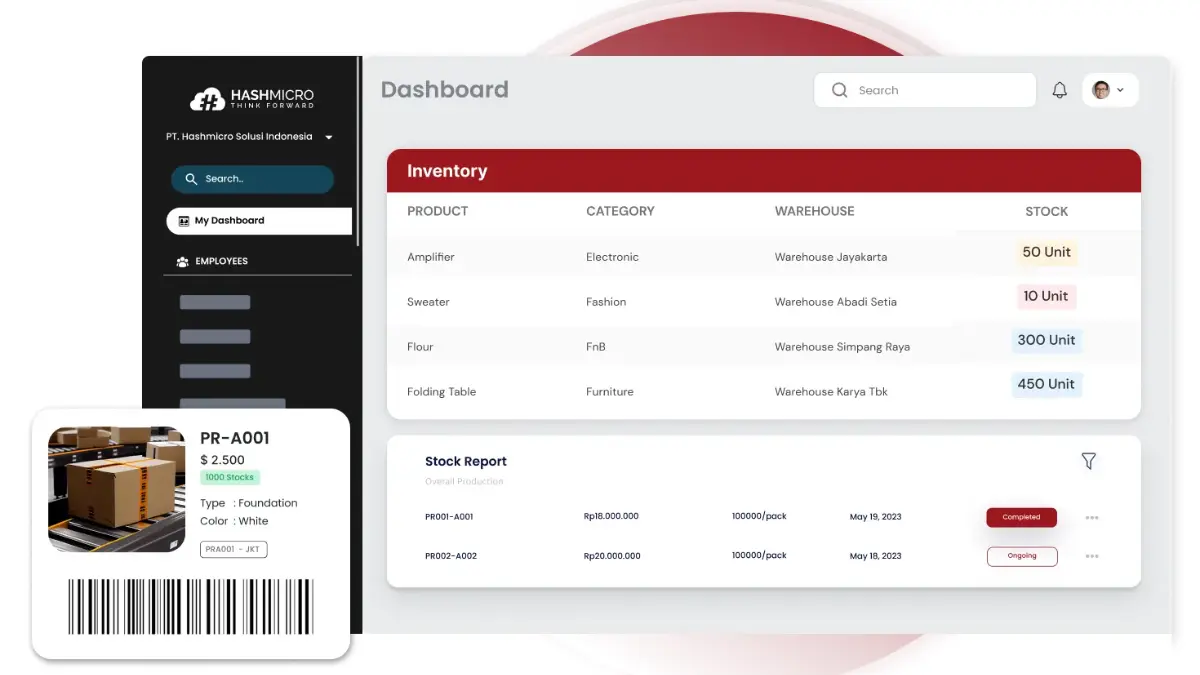Essential inventory reports help businesses manage stock efficiently and avoid costly mistakes. Without them, companies risk stock imbalances, unnecessary expenses, and missed opportunities.
Many businesses still rely on manual tracking, which often leads to errors like overordering or stock shortages. However, with the adoption of cloud-based inventory systems, companies can achieve real-time visibility and improving profitability.
Staying compliant with IRAS tax regulations requires accurate inventory records to avoid penalties. Multi-channel sales add complexity, leading to stock mismatches, lost revenue, and customer frustration.
Without real-time visibility, demand forecasting and stock optimization become challenging, affecting efficiency and profitability. Imagine your inventory system working seamlessly, keeping stock levels across all channels perfectly synchronized.
With HashMicro’s Inventory Software, you can eliminate manual errors, track stock in real time, and integrate all sales channels effortlessly. Key features like real-time tracking, Stock Forecasting, and FEFO help optimize inventory and ensure compliance.
Curious to learn more? Keep reading to discover how essential inventory reports can transform your business.
Table of Content:
Table of Content

Key Takeaways
|
What is an Essential Inventory Report?
An essential inventory report is a document that tracks stock levels, product status, and key insights for effective inventory management. It includes critical data such as total inventory quantities, top-selling items, and providing a clear snapshot of stock health.
This report is a vital tool for businesses to monitor product availability, avoid stockouts, and prevent overstocking. By following best practices in inventory reporting, companies can enhance operational efficiency, reduce costs, and improve customer satisfaction.
Whether using basic spreadsheets or advanced inventory management software, an effective reporting system simplifies tracking and analysis. With accurate data, businesses can make informed decisions, optimize stock levels, and streamline supply chain performance.
Why is Essential Inventory Reporting Important?
Inventory reporting is essential for businesses that rely on physical products. It offers valuable insights into stock levels, enabling companies to make informed decisions that improve inventory management.
By using accurate, up-to-date inventory data, businesses can streamline operations, reduce costs, and boost customer satisfaction. Here’s why essential inventory reporting is so important:
-
Enhanced inventory planning
Effective inventory reporting plays a key role in optimizing inventory planning. It helps businesses refine reorder points, forecasting, and budgeting by providing a clear picture of capital tied up in stock.
Implementing best practices ensures businesses maintain the right stock levels, avoiding overstocking or running out of critical items.
-
Real-time inventory tracking
Inventory reporting enables transparent tracking, allowing businesses to monitor stock levels in real-time. This transparency ensures that products are always available for customers, with on-time deliveries.
-
Streamlined inventory categorization
An organized inventory reporting system enables businesses to categorize products based on value, demand, and carrying costs. This structured approach allows businesses to easily identify profitable SKUs contributing to a more efficient supply chain and smoother operations overall.
What are Essential Inventory Reports Used for?
Essential inventory reports are indispensable tools for businesses aiming to streamline operations, reduce costs, and enhance overall efficiency. These reports provide a comprehensive view of stock levels and categorization, offering actionable insights that drive smarter decision-making.
Whether it’s avoiding stockouts, optimizing warehouse operations, or improving demand forecasting, inventory reports play a critical role in maintaining a well-functioning supply chain.
Below, we explore the primary uses of essential inventory reports and how they benefit your business.
-
Inventory management and demand forecasting
Inventory reports are crucial for managing stock levels and predicting future demand accurately. By analyzing historical sales data and trends, businesses can set optimal reorder points, ensuring they never run out of popular items while avoiding overstocking.
This balance helps meet customer demand efficiently without tying up excess capital in unnecessary inventory.
-
Warehouse inventory tracking
For businesses operating large warehouses, inventory reports are essential for tracking stock locations and movement. Integrated reporting systems, often paired with warehouse management system, help minimize unnecessary product handling and streamline operations.
This is especially important for perishable or time-sensitive goods, where efficient tracking ensures items are processed in the correct order, reducing waste and improving fulfillment accuracy.
-
Inventory categorization
Inventory reports help businesses organize stock into clear categories, such as raw materials, work-in-progress, and finished goods. This structured approach ensures accurate tracking of products through various supply chain stages, improving inventory valuation and accounting.
For manufacturers, categorizing inventory by production stage helps control costs, while fulfillment centers benefit from better organization, preventing mix-ups and enhancing operational efficiency.
By leveraging essential inventory reports, businesses can optimize stock levels, improve operational workflows, and ultimately deliver better customer experiences.
Types of Inventory Reports
Before diving into the various types of inventory reports, it’s essential to understand how they can be categorized. Inventory reports can generally be divided into three fundamental types: informational reports that provide data, management reports for decision-making, and time-based reports that track performance over specific periods.
Each type serves a distinct purpose and is crucial in optimizing inventory management.
1. Inventory value report
The inventory value report provides a comprehensive overview of the total monetary value of your current stock. It enables businesses to assess how much capital is tied up in inventory, which is crucial for cash flow management.
This report is crucial for financial assessments and determining the worth of stock assets. It lays the groundwork for making informed decisions about future investments or adjustments.
2. Inventory performance report
An inventory performance report measures the efficiency of inventory movement report through the supply chain. It tracks key metrics such as stock turnover rates, product velocity, and lead times, identifying delays or inefficiencies.
This data is essential for optimizing the flow of goods and ensuring timely restocking. By pinpointing bottlenecks in the inventory list, businesses can improve inventory performance and reduce holding costs.
3. Inventory forecasting report
This report uses historical data and trends to predict future stock needs, ensuring that businesses maintain optimal inventory levels. Anticipating demand fluctuations it helps avoid overstocking and stockouts.
Accurate forecasting minimizes wasted resources and storage costs while ensuring high-demand items are always available. This predictive insight is essential for businesses planning seasonal inventory or product launches.
4. Fulfillment & shipping trends report
Tracking fulfillment and shipping trends allow businesses to assess how efficiently orders are processed and delivered. This report provides insights into shipping times, fulfillment rates, and cost per shipment.
By analyzing these trends, companies can streamline logistics, reduce shipping costs, and improve delivery times. Enhancing fulfillment efficiency not only cuts operational costs but also boosts customer satisfaction.
5. Inventory profitability report
An inventory profitability report helps businesses identify which products drive the most profit. This report pinpoints high-margin items and underperforming products by analyzing the cost of goods, margins, and sales performance.
With this data, businesses can focus on stocking more profitable items and discontinuing or discounting less lucrative ones. This report is essential for optimizing the product mix and improving overall profitability.
6. Stock levels report
A stock levels report provides a real-time snapshot of the inventory quantity available across various locations. It helps businesses maintain optimal stock levels, preventing stockouts or excess inventory that could tie up capital while also incorporating inventory aging.
By regularly monitoring stock levels, companies can ensure they always have enough products to meet demand without over-investing in surplus stock. This report is critical for both retail and manufacturing operations.
If you’re considering upgrading your inventory report with inventory management software, now is the perfect time to explore how it can optimize your business processes. Click the banner below to try the free pricing calculator from HashMicro and discover the right solution for your inventory needs.
7. Sales report
A sales report tracks product performance over time, offering insights into which items are selling well, and which are not. It helps businesses understand customer buying patterns and preferences, allowing them to adjust product offerings accordingly.
This report is a crucial tool for sales forecasting and planning promotions or discounts to boost slow-moving inventory. It also informs decision-making on product lifecycle management.
8. Cost of Goods Sold (COGS) report
The COGS report calculates the total cost of producing or purchasing inventory sold during a specific period. Subtracting these costs from sales revenue helps businesses determine their gross profit.
Understanding COGS is essential for setting appropriate pricing strategies and maintaining profitability. This report also assists in tax reporting, as COGS directly impacts the bottom line and taxable income.
9. Purchase order report
This report tracks all outstanding and fulfilled purchase orders, offering a detailed view of the ordering process. It helps businesses manage supplier relationships and ensures orders are placed and received on time.
Companies can avoid restocking delays and maintain adequate inventory levels by monitoring purchase orders. This report also helps negotiate better terms with suppliers based on order history and volume.
10. Shipment trends report
A shipment trends report monitors logistics data, such as shipping costs, delivery times, and routes. It provides insights into how efficiently products are transported from suppliers to warehouses and warehouses to customers.
Businesses can identify opportunities to reduce shipping costs and improve delivery speed by analyzing shipment trends. This report is vital for companies aiming to optimize their supply chain.
11. Customer analytics report
This report offers a detailed analysis of customer behavior, including purchasing patterns, preferences, and frequency of purchases. It allows businesses to tailor their inventory to meet customer demand better and ensure the right products are in stock at the right time.
Each of these essential inventory reports plays a pivotal role in ensuring that businesses can effectively manage stock, optimize operations, and improve profitability.
By leveraging these reports, businesses can make data-driven decisions, reduce costs, and ultimately provide better service to their customers, helping them stay competitive in today’s fast-paced market.
Step-by-Step Guide to Writing a Comprehensive Essential Inventory Report
Creating an inventory report is a crucial aspect of stock management, providing valuable insights into your inventory levels, trends, and overall business performance. With following these detailed steps will ensure you build an accurate and easy-to-update report.
Step 1: Prepare Your Framework
- Choose a Tool: Decide whether to use a spreadsheet (like Microsoft Excel or Google Sheets) or inventory management software.
- Set Up Columns: Begin by setting up your columns in the report. Each column will represent a key data point, such as item name, SKU, description, stock quantity, price, and other details.
Step 2: List All Inventory Items
- Include Every SKU: Record all items individually, ensuring each Stock Keeping Unit (SKU) is listed in a separate row.
- Use Unique Identifiers: Assign a unique code to each item for easier tracking. If you’re using software, the SKU system may be auto-generated.
Example:
| SKU | Item Name |
|---|---|
| 001-A | Cotton Shirt |
Step 3: Add Descriptions
- Provide Clear Details: Add a column for product descriptions. Include details like size, color, material, model number, or any other feature that distinguishes the item.
- Why It’s Important: This step helps your team identify items quickly and minimizes errors during order fulfillment.
Example:
| SKU | Item Name | Description |
|---|---|---|
| 001-A | Cotton Shirt | Size: Medium, Color: Blue |
Step 4: Record Pricing Information
- Choose the Price Type: Decide whether you’re recording the purchase price, selling price, or both. Create separate columns if needed.
- Ensure Accuracy: Cross-check the prices to avoid discrepancies that can affect cost calculations and profit analysis.
Example:
| SKU | Item Name | Description | Selling Price | Purchase Price |
|---|---|---|---|---|
| 001-A | Cotton Shirt | Size: Medium, Color: Blue | $20.00 | $12.00 |
Step 5: Track Stock Quantities
- Add a Quantity Column: Create a column to track the remaining stock for each SKU.
- Update Regularly: Ensure this data is consistently updated to reflect changes due to sales, restocking, or returns.
Example:
| SKU | Item Name | Description | Selling Price | Stock Quantity |
|---|---|---|---|---|
| 001-A | Cotton Shirt | Size: Medium, Color: Blue | $20.00 | 50 |
Step 6: Include Inventory Movement
- Track Movements: Add columns for incoming stock, sales, returns, or damaged goods to monitor inventory changes over time.
- Why It’s Useful: This helps analyze trends and pinpoint discrepancies.
Example:
| SKU | Item Name | Stock Quantity | Incoming Stock | Sales | Returns |
|---|---|---|---|---|---|
| 001-A | Cotton Shirt | 50 | 20 | 10 | 5 |
Step 7: Calculate Inventory Value
- Add a Value Column: Multiply the stock quantity by the purchase or selling price to calculate the total value of each SKU.
- Total Inventory Value: Sum up the values of all SKUs for a complete overview.
Example:
| SKU | Stock Quantity | Purchase Price | Total Value |
|---|---|---|---|
| 001-A | 50 | $12.00 | $600.00 |
Step 8: Set Time Frames for Updates
- Determine Frequency: Choose how often you will update the report—daily, weekly, or monthly—based on your business needs.
- Automate If Possible: Use inventory management software to automate updates for real-time data accuracy.
Step 9: Analyze and Report
- Create Summaries: Use charts or tables to summarize key metrics, such as best-selling products, stock turnover, and inventory value.
- Review Regularly: Share the report with relevant team members for decision-making and forecasting.
By following these steps, you’ll create a detailed, organized inventory report that not only tracks stock accurately but also provides actionable insights to improve your inventory management and overall business operations.
HashMicro’s Inventory Management Software is perfect for businesses aiming to optimize inventory accuracy and efficiency. With advanced inventory management reporting features, it helps you manage stock levels, track trends, and avoid costly errors.
If you want to learn more about how this solution can benefit your business, sign up for a free demo today. Experience how HashMicro’s inventory reporting software can enhance your operations and offer additional features to streamline your processes.
Hence, HashMicro provides a comprehensive range of features such as:
-
RFID warehouse rack stock in-out Automation:
Automate the tracking of stock movement in and out of warehouse racks, improving both efficiency and inventory accuracy. Enhance your warehouse operations by reducing manual errors and speeding up stock handling processes.
-
OCR for receiving:
Accelerate the receiving process by automatically capturing and processing data from incoming goods. This ensures that inventory records are accurate and up-to-date. Streamline your receiving operations and reduce the time spent on manual data entry.
-
Stock forecasting:
Proactively manage stock levels by predicting future inventory needs, ensuring optimal stock availability and improved customer satisfaction. Avoid stockouts and overstocking by leveraging data-driven forecasting.
-
Run rate reordering rules:
Generate precise reordering predictions based on market trends and current inventory usage rates, ensuring sufficient stock levels without over- or understocking. Keep your warehouse fully stocked to meet demand efficiently.
-
Fast-moving, slow-moving, and non-moving stocks analysis:
Identify fast-moving, slow-moving, and non-moving stocks to optimize your inventory strategy. For example, you can prioritize procurement, create sales promotions, or phase out underperforming items. Ensure your warehouse is stocked with the right products at the right time.
-
Racking capacity with putaway strategy:
Assist warehouse teams in determining optimal storage locations, making it easier to find items and minimizing placement errors. Streamline the stocking process and maximize space efficiency with innovative putaway strategies.
-
Stock reservations & reporting:
Ensure the availability of desired items by effectively managing stock reservations and providing detailed inventory reports. By managing reserved stock seamlessly, you can improve inventory accuracy and customer satisfaction.
-
Quality control management:
Set and manage quality standards for all products stored in the warehouse, ensuring that received and dispatched items meet quality expectations. Schedule regular quality checks and swiftly identify defective or non-compliant goods to maintain high inventory standards.
Beyond these features, HashMicro excels in system integration with third-party platforms, module customization to suit unique business needs, and ensuring seamless operations for Singaporean businesses.
By implementing HashMicro, you’re choosing the best partner for achieving long-term success and operational excellence.
Download Your Essential Inventory Reports Template
To streamline your inventory management, the following Inventory Reports Template will help you track and organize stock levels efficiently, improving decision-making and operational success.
Essential inventory reports template

Additional Notes:
- Inventory Movement: Regular updates should be made to track stock fluctuations accurately.
- Total Inventory Value Calculation: Stock quantity multiplied by the purchase price for accurate valuation.
- Reorder Alerts: Items that reach or fall below the reorder level should trigger restocking actions.
- Stock Turnover Analysis: Identify slow-moving and best-selling products for inventory optimization.
- Automation Considerations: If using software, automate data entry where possible to maintain real-time accuracy.
- Update Frequency: Ensure data is refreshed on a daily, weekly, or monthly basis depending on business needs.
This refined format enhances inventory management by providing clear insights into stock levels, movement trends, and financial implications.
Conclusion
Managing inventory effectively is essential for businesses to stay profitable and efficient. With the right inventory reports, companies can track stock levels, prevent shortages, and optimize supply chains. This ensures smooth operations, better decision-making, and a stronger bottom line.
By leveraging data-driven insights, businesses can streamline stock control, forecast demand accurately, and minimize waste. Reports such as Inventory Value, Stock Levels, and Purchase Orders help maintain the right balance while keeping customers satisfied and avoiding unnecessary costs.
With the right tools, managing inventory becomes a strategic advantage rather than a challenge. Want to simplify your inventory management? inventory management software offers automation, real-time tracking, and seamless integration across all sales channels.
Eliminate manual errors, boost efficiency, and make smarter stock decisions. Try our free demo today and experience how it can transform your business.

FAQ About Essential Inventory Reports
-
What is the best way to record inventory?
The best way to record inventory is by using automated inventory management software. This solution allows real-time tracking, minimizes human error, and integrates seamlessly with your existing systems to ensure accurate and efficient inventory reporting.
-
How do you conduct inventory records?
Conducting inventory records involves regularly tracking stock levels, categorizing items, and updating data as products move in and out of your warehouse. Inventory tracking and reporting software simplifies this process by providing real-time updates and minimizing manual entry.
-
What is the simplest way to track inventory?
The simplest way to track inventory is by using inventory reporting software that automates stock updates and provides real-time data. This system reduces errors, saves time, and ensures accurate inventory levels.





































